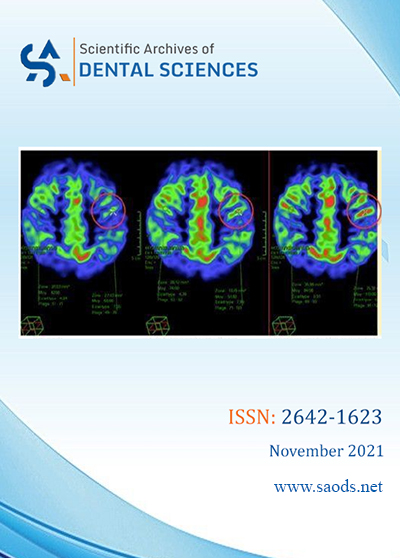SAODS – Volume 4 Issue 11

| Publisher | : | Scienticon LLC |
|---|---|---|
| Article Inpress | : | Volume 4 Issue 11 – 2021 |
| ISSN | : | 2642-1623 |
| Issue Release Date | : | November 01, 2021 |
| Frequency | : | Monthly |
| Language | : | English |
| Format | : | Online |
| Review | : | Double Blinded Peer Review |
| : | saods@scienticon.org |
Volume 4 Issue 11
Editorial
Volume 4 | Issue 11
Irineu Gregnanin Pedron
Research Article
Volume 4 | Issue 11
Vignesh Devaraju
Background: Dental caries is an important public health problem and its impact on the society and on the individual is significant. There is a need to adopt a more progressive approach towards prevention of dental caries incidence. CPP-ACP has been demonstrated to be a safe and effective tooth-decay preventive agent when used at an optimum dose of 3 – 5 g/day divided in 3 exposures. It is important to determine the effect of using CPP-ACP chewing gums within the recommended concentrations and frequencies long enough to alter the oral micro flora which in turn can retard the proliferation of Streptococcus mutans and maintain its effect even beyond interruption among the individuals who are among high caries risk groups.
Aim of the Study: To assess the effectiveness of sugar free chewing gum with CPP-ACP on streptococcus mutans count.
Materials and Methods: Sixty study subjects (first and second year undergraduate dental students) from a dental colleges based on the inclusion and exclusion criteria were assigned into two groups; Group A (Without CPP-ACP) and Group B (With CPP-ACP). The experimental period comprised of baseline data collection, intervention period for 30 days, follow-up and post intervention period for 30 days and assessed for streptococcus mutans quantification at all the time frames.
Results: The results showed that the mean age of the study subjects was 21.12 ± 1.75 years, there were significant reductions in salivary levels of streptococcus mutans at 30 days after intervention when compared to the baseline and the effect was maintained even beyond interruption. Group B showed greater amounts of streptococcus mutans counts reduction at the end of follow-up phase when compared to Group A.
Conclusion: Thus, the use of CPP-ACP chewing gums 2 pellets/2 times/day leads to increased reductions in salivary levels streptococcus mutans of even for short periods of 30 days and the effect was maintained even beyond interruption.
Keywords:CPP-ACP; Chewing Gum; Saliva; Streptococcus mutans
Research Article
Volume 4 | Issue 11
Mayank Pahadia
Keywords:Maxillary Sinus; CT; Forensic; Imaging; Radiology
Research Article
Volume 4 | Issue 11
Pramod Machani, Philip Pradeep, Siow Rachel, Annie Khor Yuan Ning and Manasvini Menon
Background: This study aims to investigate the relationship between socioeconomic status (SES) and oral hygiene status (OHI-S) among the patients visiting Penang International Dental College (PIDC).
Methodology: A cross-sectional survey involving 107 samples was selected using convenience sampling. The survey was carried out by using a pre-formulated questionnaire and OHI-S. Statistical analysis is done using descriptive statistics, Spearman’s correlation analysis, ANOVA, t-Testing, and hierarchical regression analysis.
Results: The results show that 37.4% of the respondents had poor OHI-S, 45.8% had fair OHI-S and 16.8% of the respondents exhibited good OHI-S. A strong and positive correlation between SES and OHI-S with r = 0.659 and ρ = 0.00 was shown.
Conclusion: Overall, the majority of the respondents have satisfactory oral hygiene. The result demonstrated a positive correlation between SES and OHI-S. Further research is needed to identify other reasons for the disparity in oral hygiene level besides income and education.
Keywords:Socioeconomic Status (SES); Oral Hygiene Status; Simplified Oral Hygiene Index (OHI-S)
Case Study
Volume 4 | Issue 11
Eber Stevao and Peter Maurer
Patients with dentoskeletal deformities might need Orthognathic surgery to correct their condition. In few cases further adjunctive minor procedures such as uvulopalatopharyngoplasty, adenoidectomy, inferior turbinectomies have to be concomitantly performed in order to improve the oral pharyngeal airway space. The authors on this mini review, aiming the Oral and Maxillofacial residents and/or young surgeons, intend to make ready available to them the most important topics on Cephalometric evaluation when Orthognathics is the treatment option.
Keywords:Need’s Ratio; Orthognathic Surgery; Adenoidectomy; Uvulopalatopharyngoplasty
Literature Review
Volume 4 | Issue 11
Patrick Fellus
Swallowing rehabilitation is a component to include in our treatment plan. Getting good results discourages many practitioners. We propose a totally innovative approach leading to physiological and biochemical modifications and inhibition of old circuits that do not call upon traditional time-consuming protocols. This new approach has been tested with a clinical study at CHRU University Hospital of Lille, France. The aim of the study was to determine its efficiency towards atypical swallowing in 10 weeks on 40 patients between 5 and 16 yo, all of them diagnosed with atypical swallowing. After 10 weeks of treatment, secondary deglutition was obtained for 80% of the patients including 60% automatization and “a significant decrease in the percentage value of the oral ventilation flow”. Then 15 minutes a day during a few weeks is enough to get such results and allow an easy compliance even for young children.
Keywords:Suction-Swallowing Swallowing-Mastication; Anoetic Network; Connexionism Between Networks